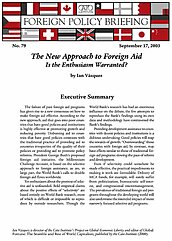Yet enthusiasm about the promise of selective aid is unfounded. Bold empirical claims about the positive effects of “selectivity” are based entirely on World Bank research, most of which is difficult or impossible to reproduce by outside researchers. Though the World Bank’s research has had an enormous influence on the debate, the few attempts to reproduce the Bank’s findings using its own data and methodology have contravened the Bank’s findings.
Providing development assistance to countries with decent policies and institutions is a dubious undertaking. Good policies will reap the rewards of growth. “Overrewarding” those countries with foreign aid, by contrast, may have effects similar to those of traditional foreign aid programs: slowing the pace of reform and development.
Even if selectivity could somehow be made effective, the practical impediments to making it work are formidable. Delivery of MCA funds, for example, will surely suffer from politicization, bureaucratic self-interest, and congressional micromanagement. The prevalence of traditional foreign aid programs throughout the developing world will also undermine the intended impact of more narrowly focused selective aid programs.


